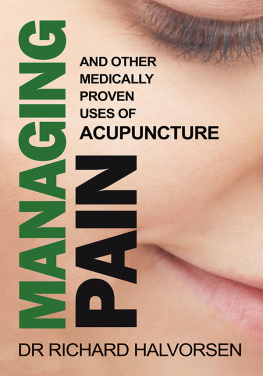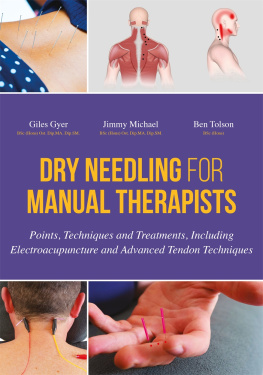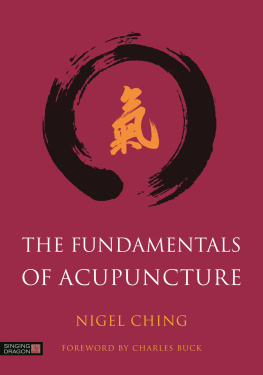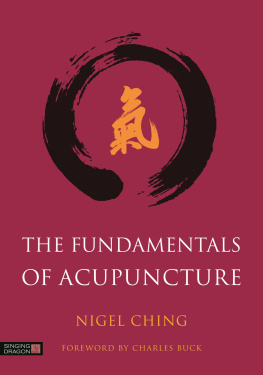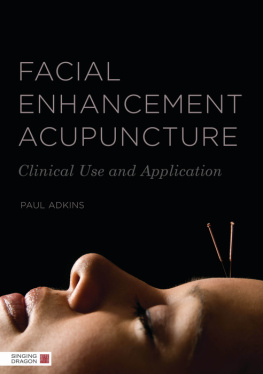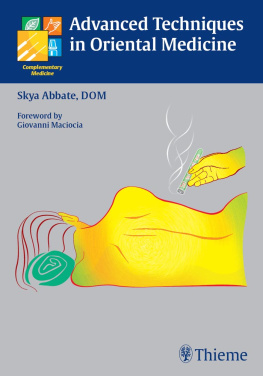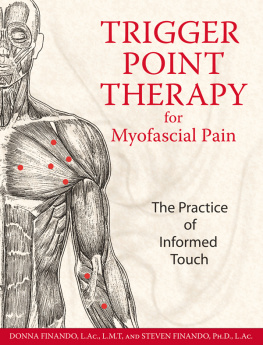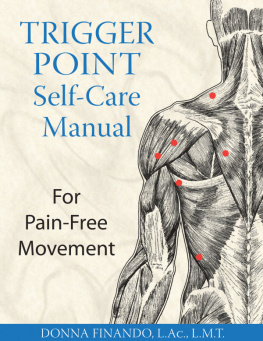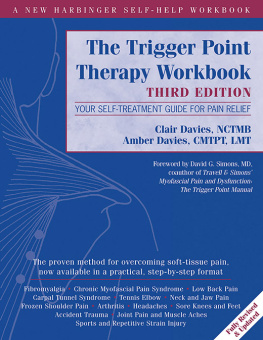DRY NEEDLING FOR
MANUAL THERAPISTS
of related interest
The Active Points Test
A Clinical Test for Identifying and Selecting Effective Points for Acupuncture and Related Therapies
Stefano Marcelli
ISBN 978 1 84819 233 1
eISBN 978 0 85701 207 4
DRY NEEDLING FOR
MANUAL THERAPISTS
Points, Techniques and Treatments, Including Electroacupuncture and Advanced Tendon Techniques
Giles Gyer, Jimmy Michael and Ben Tolson

LONDON AND PHILADELPHIA
Medical images provided by Alila Medical Images.
Photos taken by Frances Tolson (www.evokepictures.co.uk).
First published in 2016
by Singing Dragon
an imprint of Jessica Kingsley Publishers
73 Collier Street
London N1 9BE, UK
and
400 Market Street, Suite 400
Philadelphia, PA 19106, USA
www.singingdragon.com
Copyright Giles Gyer, Jimmy Michael and Ben Tolson 2016
All rights reserved. No part of this publication may be reproduced in any material form (including photocopying or storing it in any medium by electronic means and whether or not transiently or incidentally to some other use of this publication) without the written permission of the copyright owner except in accordance with the provisions of the Copyright, Designs and Patents Act 1988 or under the terms of a licence issued by the Copyright Licensing Agency Ltd, Saffron House, 610 Kirby Street, London EC1N 8TS. Applications for the copyright owners written permission to reproduce any part of this publication should be addressed to the publisher.
Warning: The doing of an unauthorised act in relation to a copyright work may result in both a civil claim for damages and criminal prosecution.
Library of Congress Cataloging in Publication Data
A CIP catalog record for this book is available from the Library of Congress
British Library Cataloguing in Publication Data
A CIP catalogue record for this book is available from the British Library
ISBN 978 1 84819 255 3
eISBN 978 0 85701 202 9
Contents
Part I
BACKGROUND
Chapter 1
Introduction
T his book is primarily for health professionals who are treating musculoskeletal (MSK) conditions and who wish to incorporate acupuncture into their practice. We acknowledge that acupuncture can treat conditions other than MSK, but that is beyond the scope of the book.
Physical therapists see many MSK problems in clinic, which makes them ideal candidates to incorporate acupuncture into their practice. Musculoskeletal problems of various types are often the most common reasons for patients to seek care from acupuncturists, representing one third to one half of all visits (Sherman et al. 2005). In one study of Chinese patients (Mao et al. 2007), patients presented with pain-related musculoskeletal complaints such as back and neck pain (53%), arthritis (41%), neurological complaints such as post-stroke rehabilitation and facial paralysis (23%), and weight loss (10%). In the United Kingdom acupuncture is used in 84 per cent of chronic pain clinics (Woollam and Jackson 1998).
Acupuncture has become more accepted by Western medicine over the last 30 years and has seen an exponential growth in its practice worldwide (Guerreiro da Silva 2013). As the practice of acupuncture has grown, so too has the evidence base. The advantages of using acupuncture are well documented and include an immediate reduction in local, referred and widespread pain, restoration of range of motion and muscle activation patterns, and a normalization of the immediate chemical environment of active myofascial trigger points (Dommerholt 2011). As well as these well-documented effects, acupuncture can have simultaneous widespread effects at multiple sites.
Acupuncture as part of manual therapy is rarely a stand-alone procedure and should be part of a broader physical therapy approach. Other approaches, including soft tissue mobilization, manipulation, therapeutic exercise and functional retraining, should be used in combination with acupuncture. For example, after deactivation of myofascial trigger points, patients should be educated in appropriate self-care techniques which may include specific stretches of the involved muscles and self-massage techniques (American Physical Therapy Association 2013).
As the appetite for acupuncture has grown, there now exist varying standards of training. The requirements for acupuncture training have yet to be provided and vary considerably in practice. Broadly speaking there are two main training routes for acupuncture: courses for lay persons and courses for medically qualified practitioners.
Those courses which are mainly for lay persons are generally very comprehensive and will include a mixture of standard Western anatomy and pathology with a large percentage of traditional Chinese medicine (TCM). TCM theory is extremely complex, takes a long time to learn and includes pulse and tongue diagnosis amongst other techniques.
The courses attended by medically qualified practitioners are usually much shorter. This is because, in the case of doctors and allied health professionals, their knowledge of diagnosis, pathology, anatomy, physiology, microbiology and other treatment techniques that can be used at the same time as acupuncture can be taken for granted.
White (2009, p.33) defines dry needling (also know as Western medical acupuncture) as a therapeutic modality involving the insertion of fine needles; it is an adaptation of Chinese acupuncture using current knowledge of anatomy, physiology and pathology, and the principles of evidence-based medicine. Although Western medical acupuncture has evolved from Chinese acupuncture, its practitioners no longer adhere to concepts such as yin/yang and circulation of qi, and regard acupuncture as part of conventional medicine rather than a complete alternative medical system. For convenience, however, the term acupuncture will be used throughout this book.
Hong (2013, p.593) describes acupuncture as covering a diverse academic field that spans from ancient medical history to the most advanced contemporary neurophysiology. He continues: Acupuncture as a treatment for pain encompasses much more than simply needling: it involves a complex interaction and context that may include empathy, touch, intention, attention, expectation and conditioning.
The term dry needling is often used to differentiate this technique from myofascial trigger point injections. Myofascial trigger point injections are performed with a variety of injectables, such as: procaine, lidocaine and other local anaesthetics; isotonic saline solutions; non-steroidal anti-inflammatories; corticosteroids; bee venom; botulinum toxin; and serotonin antagonists (Dommerholt, del Moral and Grbli 2006).
Many acupuncturists see the use of so-called dry needling/Western medical acupuncture as an infringement of the rights of traditional acupuncture practitioners. It is the position of some organizations that any intervention utilizing dry needling beyond trigger point dry needling is the practice of acupuncture, regardless of the language utilized in describing the technique. Acupuncturists will argue that by using acupuncture in their practice practitioners may inadvertently be affecting the whole organism without realizing it.
Whether acupuncture falls within the confines of a single discipline or should be incorporated into physical therapy remains a question to be answered by individuals and the respective organizations or governing bodies. Currently in some parts of the world this has resulted in a turf war where legislation has been passed banning the use of acupuncture within manual or physical therapy.
Next page


